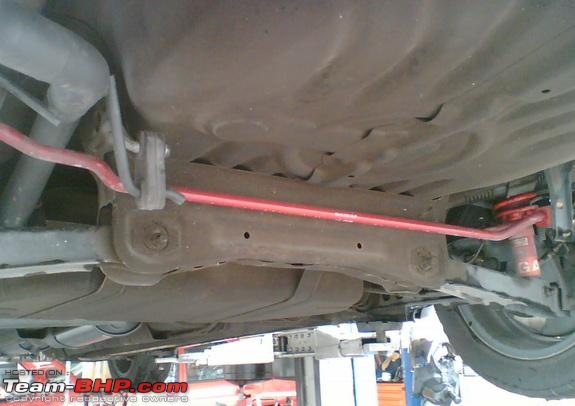Quote:
Originally Posted by alexnazim  Now a strut brace would be something that prevents the shocker from expanding beyond a limit. But is there something that prevents a shocker from contracting beyond a limit?
My esteem's new rear shockers tend to make the chassis touch the wheels pretty often with 3 people sitting at the back. |
Bro, i think you are getting it wrong. Strut braces are
not meant to controll vertical movement of the suspensions(mainly the struts).
They only control lateral flex, inward and outward movement rather than expansion and contraction if you will.
My two cents on the topic:-

This is what a
lower tie rod/lower tie bar/lower strut brace looks like. The sole purpose of a lower tie bar is to prevent the lower ends of the struts to flex during hard cornering.
A
strut brace/strut tower brace/upper strut brace on the other hand prevents the upper part of the chasis to flex under load(hard cornering) by connecting the struts together.

This strut brace has connectors to the firewall. As the struts flex under hard cornering they need to be connected to the strongest part of the chasis for maximum benefit out of a strut brace otherwise you do find a definate improvement in handling but with the tower to tower brace its just more of a weight transfer.

This is an
anti-roll bar/sway bar/anti-sway bar/stabilizer bar. Its sort of a U shaped bar, connecting suspensions at two opposing points.
Out of the above two, this one is the most complex as the stiffness of the material, geometry of the mounting points, lenght of the lever arms, etc all contribute to the way it functions and to what degree body-roll is controlled. When the suspensions and wheels flex under stress of cornering the anti roll bar will rotate about its mounting points or twist. Of-course as the name suggest, its function is to reduce body roll by tranfering weight from one side to another.
There is lots to know about pros and cons of using an anti-roll bar.
DO KEEP IN MIND THAT NONE OF THE ABOVE CONTROLS REGULATES OR ALTERS SPRING RATINGS, DAMPER STIFFNESS,
NOTHING TO DO WITH VERTICAL MOVEMENT OF THE SUSPENSIONS(SPRINGS AND DAMPERS).
Hope i could help.
MODS : Please delete previous post number 58 as i was having difficulties with uploading the pics and have sent a complaint through the Contact Form too. Thanks!


 (2)
Thanks
(2)
Thanks
 (4)
Thanks
(4)
Thanks








 ??
??